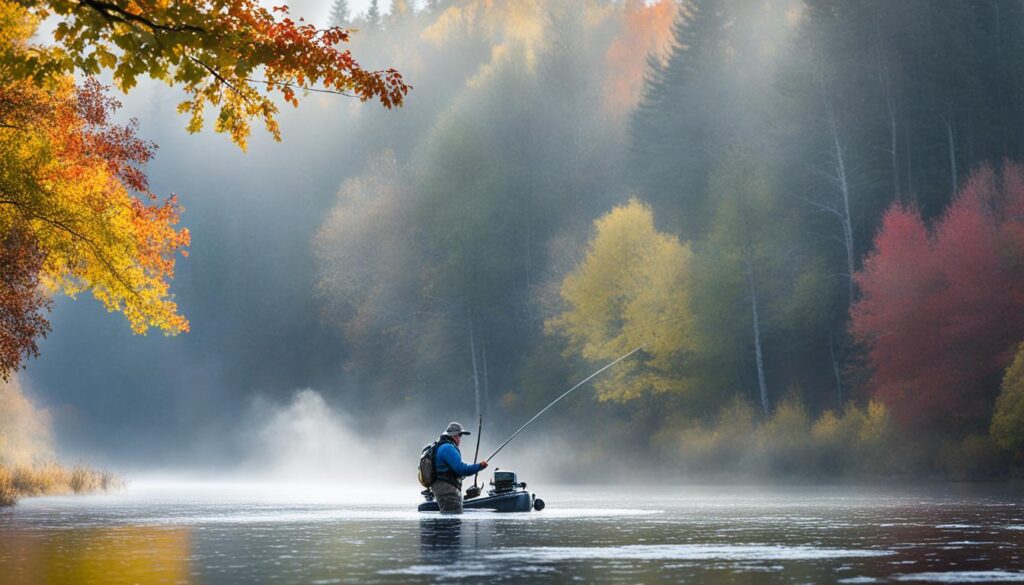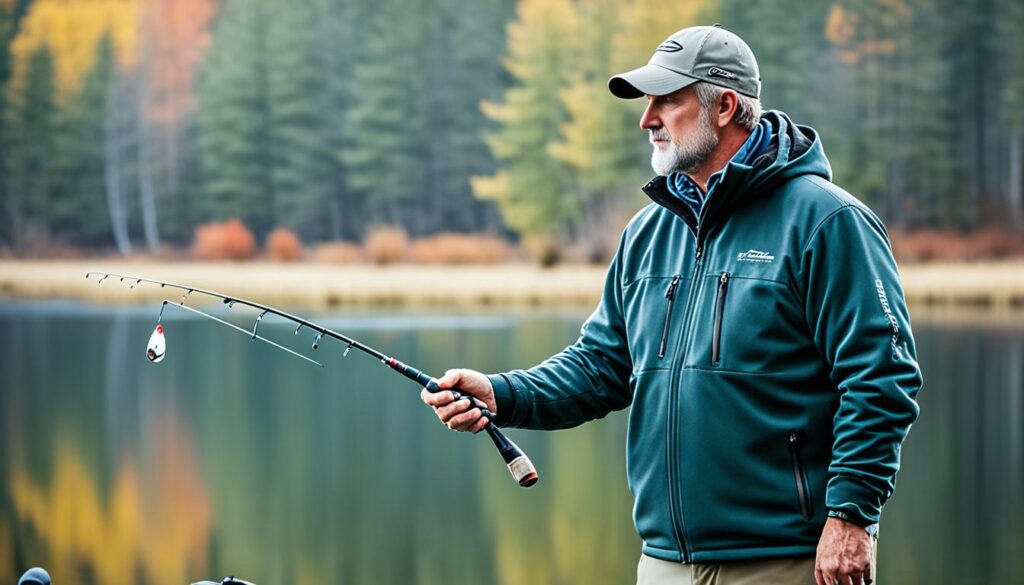Welcome to the prime season for bass enthusiasts – late fall. This period proves exceptionally rewarding for bass fishing, particularly when employing the effective Late Fall Bass Spoon. These versatile lures, combined with specialized treble hooks, attract and trigger strikes from bass congregated in schools. In this article, I’ll divulge expert tips and techniques for maximizing your success in late fall bass fishing with spoons.
Angler’s Essentials:
- Use line-thru spoons for line twist elimination and better performance in colder weather.
- Match the size and color of the spoon to the predominant forage in the area.
- Enhance treble hooks with flash and vibration for increased attraction.
- Manage line through spoons with a bobber stop for better control and mimicry of a school of baitfish.
- Position the boat strategically to minimize spooking and improve bait contact.
Benefits of Using Line-Thru Spoons
Spoon lures offer versatile presentations and several benefits, making them a staple lure for many anglers. Their metallic shine and tight wobble mimics injured baitfish, offering increased fish-attracting action in the water. By triggering predatory instincts, the flash and movement of spoons draw strikes from gamefish. Anglers can also capitalize on the versatility of spoons to target species across freshwater and saltwater habitats. Their effectiveness at catching bass, trout, pike, walleye, salmon, redfish, and snook means they remain a vital weapon for most tackle boxes.
Beyond fish-catching versatility, spoons also provide versatility in application methods for anglers. They can be fished via casting, vertical jigging, trolling, or ice fishing techniques. Their density gives them castability for effectively reaching distant targets. Attaching a spoon behind a barrel swivel allows anglers to decrease line twist issues when fishing with monofilament lines. With ease of use for most techniques and the ability to adapt presentations to habitat and conditions, it’s no wonder seasoned anglers rely heavily on the versatility and fish-catching action that spoons provide.
Unique Design for Improved Performance
Line-thru spoons deliver versatile presentations for tempting fish year-round. However, they shine brightest for most species from spring through fall – essentially ice-out until ice-over. Their flash and fluttering action mimics vulnerable baitfish perfectly during warmer conditions when most gamefish are actively feeding in preparation for spawning and winter.
Techniques like casting, jigging, trolling, and ice fishing with line-thru spoons can produce bass, walleye, salmon, trout, pike, and more from March through November. Are you targeting trophy-striped bass? Focus efforts in the early morning and late evening during peak fall feeding times in October through December.
While effective for some species outside of spring and fall, the warming water heating shallows and baitfish becoming abundant makes those prime seasons for most gamefish chasing meals. For opportunistic predators, the line-thru spoon becomes an easy meal they cannot refuse. Prepare to entice savage strikes when matching the hatch with the right colored spoon during peak feeding cycles in spring through fall.
Aerodynamic Shape for Deep-Water Applications
The distinct shape of line-thru spoons allows anglers to target fish in deep water effectively. Their tight wobble and flashing metal finish mimics struggling baitfish, triggering strikes from lurking predators. Durable construction stands up to toothy species and bottom structure. Varying retrieve speeds provoke attacks to match fish moods and preferences. With versatile action and proven fish-catching ability in the depths, line-thru spoons are ideal for deep-water fishing.
The Unique Design of Line-Thru Spoons
Add line-thru spoons to your tackle as temperatures drop for increased late-fall success. Their slender shape transmits maximum flash and erratic wobble to mimic vulnerable baitfish, provoking strikes from depth-dwellers. Twisted line issues cease with the single wire leader tie point. Quickly eliminating twists enables efficient fish targeting in cold water when the action gets lethargic. Durable metal construction stands up to rugged scenarios and toothy species while dropping swiftly to put the bait where fish hide. With unrivaled action for the conditions, line-thru spoons are deadly late-fall tools every angler should use.
Matching Spoon Size and Color to Forage
Selecting spoons for fishing requires careful consideration to “match the hatch,” aligning with local baitfish in size and color. This practice mimics natural prey, increasing the chances of attracting fish. Whether in fresh or saltwater, aligning jigs with the profile and color of local baitfish is recommended for success. In fly fishing, adapting artificial flies to match local hatches is crucial. The principle extends to spoon fishing for trout, where sizes and colors should correspond to the trout’s current baitfish.
Watching caught fish for local clues is an effective strategy, and choosing brighter colors when shad is prevalent is advised. In late fall bass fishing, selecting the right spoon is crucial. Could you look over the prevailing forage and match the spoon size and color accordingly to imitate the baitfish the bass feed on closely? During this season, bass target specific prey species, so opt for spoons that resemble their size, finish, and color to mimic the baitfish. Size is crucial; choose spoons that match the size of the local baitfish, and consider color patterns that mimic the predominant hues of the baitfish.
These recommendations are adaptable and may vary based on specific locations and conditions. Observing local forage and adjusting spoon selection accordingly is always a good idea.
Pro Tip: When fishing in clear water, consider using spoons with a natural color finish, such as silver, gold, or white. Opt for spoons with brighter colors or a chartreuse finish in stained or murky water to enhance visibility.
Example Spoon Size and Color Chart:
| Recommendations for Spoons in Clear Water | Explanation |
| Silver plated spoons | Mimic the natural silver appearance of baitfish. |
| Incorporate bright colors or flash into silver spoons | Enhance visibility and attractiveness to draw strikes. |
| Match the hatch – select spoons that match local baitfish size and color | Closely resembling available food sources entices more fish to strike |

Enhancing Treble Hooks for Increased Attraction
Treble hooks are a crucial component of your spoon fishing setup, but they can also be utilized as lures themselves to enhance your chances of a successful catch. By adding additional flash and vibration to your treble hooks, you can make them a primary target for bass, improving the overall effectiveness of your lures. To achieve this, consider experimenting with colored resin and feathered hooks for added attraction.
Colored resin is an excellent way to create eye-catching and realistic-looking hooks. By coating the hooks with brightly colored resin, you can mimic the appearance of wounded or disoriented prey, enticing the bass to strike. The vibrant colors of the resin can catch the attention of both curious and aggressive bass, increasing your chances of hooking a trophy-sized fish.
Feathered hooks are another practical option for enhancing treble hooks. The addition of feathers creates lifelike movement and provides an enticing flutter underwater. The gentle movements of the feathers can mimic the motion of baitfish or insects, attracting the attention of bass and triggering their predatory instincts. This added action and commotion can make your lure stand out and entice bass into striking.
Tip: When using colored resin or feathered hooks, it’s essential to pair them with the appropriate spoon size and color that matches the prevalent forage in your fishing area. This combination will maximize the effectiveness of your presentation, increasing your chances of attracting bites.
Managing Line Thru Spoons with a Bobber Stop
When using line thru spoons for late fall fishing, one common issue anglers face is their tendency to “wander” up the line due to their design. This movement can disrupt the presentation and reduce your chances of attracting strikes. However, a simple solution exists to control this behavior and increase your success.
Could you add a Bobberuorocarbon leader to manage the line-through-spoon movement? Stop to your fl A bobber stop is a small device that can be adjusted along the leader to create separation between the spoon and the bladed treble. By varying the position of the bobber stop, you can mimic the appearance of a school of baitfish, enticing nearby bass to strike.
Why Use a Bobber Stop?
Incorporating a bobber stop is essential for preserving the ideal alignment of the line through the spoon during retrieval. Without a bobber stop, the spoon may ascend along the line and come into contact with the treble hook, resulting in tangled lines and impeding the spoon’s natural action, diminishing its effectiveness. Anglers often utilize a bobber stop in a line-thru-spoon setup to regulate the fishing depth accurately. This method enables precise depth control, mainly targeting fish at specific water depths.
“Using a bobber stop allows me to fine-tune my line through spoon presentation. It prevents the spoon from sliding up the line and maintains the desired position, imitating a school of baitfish. This simple adjustment has made a noticeable difference in my late fall fishing success.”
– Expert angler
How to Use a Bobber Stop
Setup:
- Match a spinning reel to a 7 to 8-foot medium-light action rod with a 4 to 6 lb. test monofilament line.
- Tie a double overhand knot on your main line using a 10 lb monofilament line as the slipknot for the bobber stop.
- Place a small bead on your line and slide it to the knot.
- You can place your slip bobber on the line and tie it to a suitable spoon like a Swedish Pimple, Vingla, or Flute Spoon.
Adjustment:
- To adjust the depth setting of the bobber, slide the 10 lb test knot up and down the 6 lb test mainline. This action raises or lowers the spoon to the desired depth.
Fishing Technique:
- Drop your line to the bottom and raise it up one foot. Set your small bobber.
- Twitch the rod tip just enough to tip the bobber on end in the water (about 1 inch). Allow it to sit shivering from the cold, which is about the right action.
- Set the hook when you see any tip of the bobber moving in any direction.
Positioning the Boat for Minimal Spooking
Reducing the spooking factor is crucial when targeting highly-pressured fisheries to optimize your late-season bass fishing success. Boat positioning plays a significant role in minimizing disturbances and maximizing your chances of enticing bass bites. By strategically positioning your boat upwind or downwind of the bait, you can create a direct connection between you and the fish for improved bite detection and more responsive movement.
Positioning your boat up or downwind of the bait allows for a straight line between you and the fish. This straight line will enable you to maintain direct contact with your bait, ensuring you can detect even the slightest nibble. Casting perpendicular to the wind should be avoided, as it creates a line bow that reduces contact with the bait and makes it more difficult to detect bites.

Positioning your boat up or downwind eliminates the risk of casting shadows on the water and spooking the bass. This strategic maneuver lets you present your bait effectively and encourage strikes from wary late-season bass.
Regarding bait presentation and maintaining stealth on the water, carefully consider your boat position for minimal spooking. By prioritizing this aspect of your fishing strategy, you can significantly enhance your chances of success and land more late-season bass.
Choosing the Right Rod and Line Setup
Optimal equipment selection is crucial for successful late fall spoon fishing. Regarding the rod, I recommend using a medium to medium-light power rod with a soft tip that transitions into a solid backbone. This combination provides the right balance of sensitivity and strength to handle bass strikes and facilitate accurate hook sets effectively.
Could you pair your chosen rod with a Hi-Vis braided mainline? The bright color of the line allows for better visibility and makes it easier to detect subtle bites, especially in low-light conditions. Additionally, a braided line offers superior strength and sensitivity, allowing you to feel even the slightest vibrations or movements.
For the leader, opt for fluorocarbon. The Fluorocarbon line is virtually invisible underwater, providing a stealthy presentation that can make a difference in enticing wary late-fall bass. It also has excellent abrasion resistance and sensitivity, enhancing your ability to detect strikes and ensuring a solid hook set.
Here’s a quick summary of the recommended rod and line setup:
| Rod | Mainline | Leader |
|---|---|---|
| Medium-Light to Medium Rods (9-10 feet in length) | 6lb Braided line | 6lb Fluorocarbon line |

Making Small Moves to Maintain Contact with Schools
In late fall, smallmouth schools tend to roam the area, making it crucial to make minor moves to stay connected with the school. You should use the spot-lock feature on your boat to maintain contact with the bass. You can pin your boat up or downwind of the fish using spot-lock, allowing you to fan cast the area systematically and cover more ground.
If you are not getting any bites, it’s time to make small moves in the immediate vicinity. This can involve changing your casting angle, adjusting your retrieval speed, or even moving a few feet in any direction. These minor adjustments can make a big difference in regaining contact with the school and enticing the bass to bite.
Be patient and persistent, as late fall bass fishing requires a systematic approach. By making small moves and adapting to the behavior of the fish, you’ll increase your chances of success on the water.
| Moving Tactics | Tips |
|---|---|
| Adjust Retrieval Speed | Try varying your retrieval speed to mimic the natural movement of the forage and trigger a reaction strike. |
| Getting bites, please | make small moves in the immediate vicinity to find the active fish and stay in touch with the school. |
Using Heavier Slab Spoons in High Winds
When it comes to bass fishing in late fall, windy conditions can present a challenge. However, you can still have a successful outing by adjusting your tackle and technique. One effective strategy is utilizing heavier slab spoons to withstand solid gusts and maintain bottom contact.
Unlike traditional spoons, slab spoons have a more substantial weight, which helps them stay in the strike zone despite the mighty wind. Additionally, slab spoons typically have less flutter action compared to lighter models, allowing for better control and stability in windy conditions. This ensures the spoon remains enticing to the bass even when the wind is relentless.
Using heavier slab spoons in high winds during late fall can maximize your chances of attracting and catching quality bass. Please choose the appropriate size and color that mimic the local forage to entice the fish further.
| Advantages of Heavier Slab Spoons in High Winds | Benefits |
|---|---|
| Increased Weight | Maintains bottom contact and stays in the strike zone |
| Less Flutter Action | Improves control and stability in windy conditions |
| Increased Attraction | Entices bass despite adverse weather conditions |
Justin Atkins’ Spoon Fishing Insights
As a professional angler with extensive experience and success in spoon fishing, I can confidently say that late fall is an ideal time to use spoons for bass fishing. During this season, basses become more bait-oriented, mainly focusing on shad as their primary food source. With their baitfish-like design, spoons can effectively imitate shad and trigger aggressive strikes from bass.
To maximize your chances of success, I suggest exploring creek arms and fingers off the main lake. These areas often provide shelter and forage for bass, making them prime feeding grounds. You can use your electronics to locate schooling fish, as they congregate in concentrated schools during late fall.
“Late fall is an exciting time for spoon fishing. Bass actively feed on shad, and spoons are the perfect imitators. To increase your chances of success, explore creek arms and fingers off the main lake, as these areas often hold concentrated schools of bass. Use your electronics to locate these schools and present your spoon in a way that mimics the natural movement of shad.”
Spoon Selection and Presentation Tips from Justin Atkins
When fishing for bass in late fall, using the right spoon is crucial for success. Justin Atkins, a seasoned angler, recommends homemade spoons with slightly wider bodies during this time of year. These spoons create the desired flutter and slower fall rate, making them more appealing to bass.
To work the spoon effectively, Atkins suggests using your reel. Start by cranking hard for a few spins to give the spoon some action, then allow it to fall naturally. The number of cranks will vary depending on your fishing depth. Remembering subtle movements is critical when presenting the spoon to the bass.
“When spoon fishing in late fall, paying attention to the fish’s preference for bite detection is crucial. The slightest movement or change in the spoon’s action can trigger a strike. Take your time, experiment with different techniques, and watch for those subtle bites.”
In summary, late fall fishing requires thoughtful spoon selection and presentation. Using homemade spoons with wider bodies provides the desired flutter and slower fall rate while working the spoon with your reel and paying attention to the fish’s preferences can make all the difference. Following these tips from Justin Atkins will increase your chances of success during late fall fishing.
Conclusion
Late fall provides a prime opportunity to refine your spoon fishing techniques for bass. By incorporating line-thru spoons, matching the size and color of the spoons to the forage, enhancing treble hooks, and managing the movement of the bait, you can significantly increase your chances of success. But these strategies alone are not enough.
To maximize your results, it’s crucial to position your boat strategically, choose the right rod and line setup, make small moves to maintain contact with schools, and adjust for windy conditions.
Listening to the advice of experts like Justin Atkins can also be invaluable. Experiment with different spoons and presentations to find what works best for you. Remember, late fall bass fishing is all about precision and finesse. Pay attention to the subtle movements and preferences of the fish, and you’ll be well on your way to a successful fishing trip.
So, as the late fall season rolls in, grab your rod, reel, and assortment of spoons and head out to the water. With the knowledge and strategies outlined in this article, you’re well-equipped to tackle the challenges of late fall bass fishing. Good luck, and happy fishing!
FAQ
Do you have some tips for refining spoon fishing techniques in late fall?
Late fall is an excellent time to refine your spoon fishing techniques for bass. Incorporating line-thru spoons, matching the size and color to the forage, enhancing treble hooks, and managing the bait’s movement can significantly increase your success. Positioning the boat strategically, using appropriate rod and line setups, making small moves, and adjusting for windy conditions are essential for maximizing your late fall bass spoon fishing results.
What are the benefits of using line-thru spoons in late fall fishing?
Line-thru spoons have a unique design that eliminates line twists and reduces leverage against the bait once hooked. Their thin and aerodynamic shape allows them to cut through the water and sink quickly, making them ideal for deep-water applications in colder weather.
How can I match the spoon size and color to the forage in late fall bass fishing?
When choosing a spoon for late fall bass fishing, it’s essential to consider the predominant forage in the area. Opt for spoons that closely match the size, finish, and color of the baitfish the bass are actively feeding on. This baitfish imitation will increase your chances of attracting bites.
How can I enhance treble hooks for increased attraction in late fall fishing?
Treble hooks are not just functional components; they can be treated as lures. Adding flash and vibration to treble hooks can improve the overall effectiveness of your lures and make the hooks a primary target for bass. Consider experimenting with colored resin and feathered hooks for additional attraction.
How can I manage line through spoons with a bobber stop in late fall fishing?
Line thru spoons tend to “wander” up your line due to their design. Consider adding a bobber stop to your fluorocarbon leader to control this movement. Vary the position of the bobber to create separation between the spoon and the bladed treble. This separation can mimic a school of baitfish and increase your chances of triggering strikes.
What do you think is the best way to position the boat for minimal spooking in late fall fishing?
To reduce the spooking factor on highly pressured fisheries, it is recommended to position the boat either upwind or downwind of the bait. This positioning allows for a straight line and direct connection to the bait for more responsive movement and improved bite detection. Casting perpendicular to the wind should be avoided, as it creates a line bow that reduces contact with the bait.
What rod and line setup should I choose for late fall bass fishing?
Optimal equipment selection is crucial for successful late fall spoon fishing. A medium to medium-light power rod with a soft tip that transitions into a solid backbone is recommended. Pair this rod with a high-vis braided mainline and a fluorocarbon leader for improved bite detection and hook setting. Combining a bright line and a stealthy fluorocarbon leader provides visibility and stealthiness in the water.
How can I make minor moves to maintain contact with schools in late fall bass fishing?
Smallmouth schools in late fall tend to roam the area, so it’s important to make minor moves to maintain contact with the school. Utilize a spot-lock feature on your boat to pin it up or downwind of the fish; then, fan cast the area systematically. If you stop getting bites, make small moves in the immediate vicinity to regain contact with the school.
What should I do when fishing in high winds during late fall?
When fishing in windy conditions during late fall, consider upsizing to a heavier slab spoon with less flutter action. This will help maintain bottom contact despite the strong wind. The increased weight of the spoon will ensure that it stays in the strike zone and increases your chances of attracting bass.
What are some spoon selection and presentation tips from Justin Atkins for late fall bass fishing?
Justin Atkins recommends using homemade spoons with slightly wider bodies in the fall, as they produce the desired flutter and slower fall rate. He advises working the spoon using the reel, cranking hard for a few cranks, and then letting it fall. The number of cranks will vary depending on the depth of the fish. Subtle movements are essential, and paying attention to the fish’s preference for bite detection is crucial.
